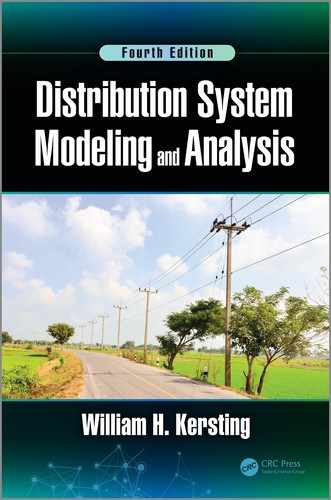Contents
1. Introduction to Distribution Systems
1.5 Distribution Feeder Electrical Characteristics
2.3 Distribution Transformer Loading
2.3.2 Maximum Diversified Demand
2.3.4 Maximum Noncoincident Demand
2.4.1.1 Application of Diversity Factors
2.4.1.3 Transformer Load Management
2.4.1.4 Metered Feeder Maximum Demand
2.4.2 Voltage Drop Calculations Using Allocated Loads
2.4.2.1 Application of Diversity Factors
2.4.2.2 Load Allocation Based upon Transformer Ratings
3. Approximate Method of Analysis
3.4 Uniformly Distributed Loads
3.4.3 The Exact Lumped Load Model
3.5 Lumping Loads in Geometric Configurations
4. Series Impedance of Overhead and Underground Lines
4.1 Series Impedance of Overhead Lines
4.1.1 Transposed Three-Phase Lines
4.1.2 Untransposed Distribution Lines
4.1.4 Modified Carson’s Equations
4.1.5 Primitive Impedance Matrix for Overhead Lines
4.1.6 Phase Impedance Matrix for Overhead Lines
4.1.8 Parallel Overhead Distribution Lines
4.2 Series Impedance of Underground Lines
4.2.1 Concentric Neutral Cable
4.2.3 Parallel Underground Distribution Lines
5. Shunt Admittance of Overhead and Underground Lines
5.1 General Voltage Drop Equation
5.2.1 The Shunt Admittance of Overhead Parallel Lines
5.3 Concentric Neutral Cable Underground Lines
5.4 Tape-Shielded Cable Underground Lines
5.6 The Shunt Admittance of Parallel Underground Lines
6. Distribution System Line Models
6.2.1 The Three-Wire Delta Line
6.2.2 The Computation of Neutral and Ground Currents
6.3 The Approximate Line Segment Model
6.4 The Modified “Ladder” Iterative Technique
6.5 The General Matrices for Parallel Lines
6.5.1 Physically Parallel Lines
6.5.2 Electrically Parallel Lines
7.2 Two-Winding Transformer Theory
7.3 Two-Winding Autotransformer
7.4.1 Single-Phase Step-Voltage Regulators
7.4.1.1 Type A Step-Voltage Regulator
7.4.1.2 Type B Step-Voltage Regulator
7.4.1.4 The Line Drop Compensator
7.4.2 Three-Phase Step-Voltage Regulators
7.4.2.1 Wye-Connected Regulators
7.4.2.2 Closed Delta-Connected Regulators
7.4.2.3 Open Delta-Connected Regulators
8. Three-Phase Transformer Models
8.3 The Delta–Grounded Wye Step-Down Connection
8.4 The Delta–Grounded Wye Step-Up Connection
8.5 The Ungrounded Wye–Delta Step-Down Connection
8.6 The Ungrounded Wye–Delta Step-Up Connection
8.7 The Grounded Wye–Delta Step-Down Connection
8.9 The Grounded Wye–Grounded Wye Connection
8.10 The Delta–Delta Connection
8.12 Thevenin Equivalent Circuit
9.1.1 Constant Real and Reactive Power Loads
9.1.2 Constant Impedance Loads
9.2.1 Constant Real and Reactive Power Loads
9.2.2 Constant Impedance Loads
9.2.5 Line Currents Serving a Delta-Connected Load
9.3 Two-Phase and Single-Phase Loads
9.4.1 Wye-Connected Capacitor Bank
9.4.2 Delta-Connected Capacitor Bank
9.5 Three-Phase Induction Machine
9.5.2 Symmetrical Component Analysis of a Motor
9.5.3 Phase Analysis of an Induction Motor
9.5.4 Voltage and Current Unbalance
9.5.6 The Equivalent T Circuit
9.5.9 Induction Machine Thevenin Equivalent Circuit
9.5.10 The Ungrounded Wye–Delta Transformer Bank with an Induction Motor
10. Distribution Feeder Analysis
10.1.1 The Ladder Iterative Technique
10.1.3 The Unbalanced Three-Phase Distribution Feeder
10.1.4 Applying the Ladder Iterative Technique
10.1.5 Let’s Put It All Together
10.1.7.2 IEEE 13 Bus Test Feeder
10.1.8 Summary of Power-Flow Studies
10.2.1 General Short-Circuit Theory
10.2.2 Specific Short Circuits
10.2.3 Backfeed Ground Fault Currents
10.2.3.1 One Downstream Transformer Bank
10.2.3.2 Complete Three-Phase Circuit Analysis
10.2.3.3 Backfeed Currents Summary
11. Center-Tapped Transformers and Secondaries
11.1 Center-Tapped Single-Phase Transformer Model
11.1.2 Center-Tapped Transformer Serving Loads through a Triplex Secondary
11.2 Ungrounded Wye–Delta Transformer Bank with Center-Tapped Transformer
11.2.1 Basic Transformer Equations
11.3 Open Wye–Open Delta Transformer Connections
11.3.1 The Leading Open Wye–Open Delta Connection
11.3.2 The Lagging Open Wye–Open Delta Connection
11.5.1 Ungrounded Wye–Delta Connection
11.5.2 Open Wye–Delta Connections
11.5.3 Comparisons of Voltage and Current Unbalances
